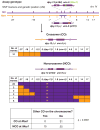Robust crossover assurance and regulated interhomolog access maintain meiotic crossover number
- PMID: 22144627
- PMCID: PMC3360972
- DOI: 10.1126/science.1212424
Robust crossover assurance and regulated interhomolog access maintain meiotic crossover number
Abstract
Most organisms rely on interhomolog crossovers (COs) to ensure proper meiotic chromosome segregation but make few COs per chromosome pair. By monitoring repair events at a defined double-strand break (DSB) site during Caenorhabditis elegans meiosis, we reveal mechanisms that ensure formation of the obligate CO while limiting CO number. We find that CO is the preferred DSB repair outcome in the absence of inhibitory effects of other (nascent) recombination events. Thus, a single DSB per chromosome pair is largely sufficient to ensure CO formation. Further, we show that access to the homolog as a repair template is regulated, shutting down simultaneously for both CO and noncrossover (NCO) pathways. We propose that regulation of interhomolog access limits CO number and contributes to CO interference.
Figures




References
Publication types
MeSH terms
Substances
Grants and funding
LinkOut - more resources
Full Text Sources
Other Literature Sources
Research Materials

